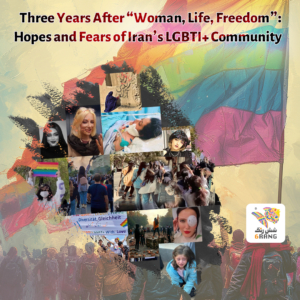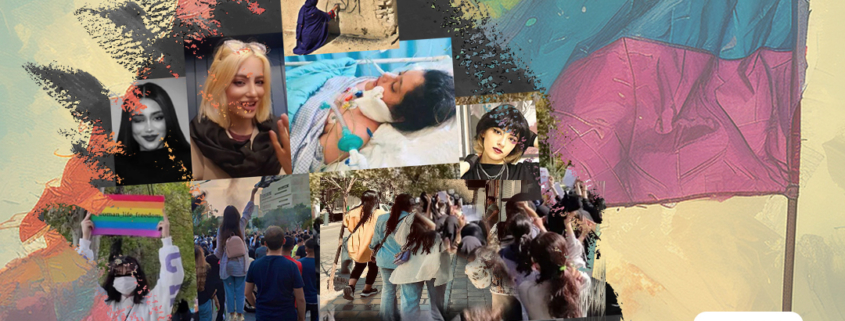Three Years After “Woman, Life, Freedom”: Hopes and Fears of Iran’s LGBTI+ Community
Three years have passed since the “Woman, Life, Freedom” uprising, a movement that not only shook Iran’s streets but also redefined the public presence of marginalized voices. For the first time, members of Iran’s LGBTI+ community took part in nationwide protests, standing shoulder-to-shoulder with other citizens demanding change.

But three years on, how have hopes and fears evolved within this community?
To find out, 6Rang spoke with several LGBTI+ Iranians from different cities and walks of life.
Glimmers of Hope, Lasting Scars
Arad, a gay Kurdish man from Tehran, recalls those early days with both pride and emotion:
“Mahsa was Kurdish; I’m Kurdish too. My conscience wouldn’t let me stay silent. I went to the streets full of hope, believing everything could change. What gives me hope now is how much more aware people have become. Society is opening up, and more experts and allies are finding their place. People have big concerns, yet sometimes they see us standing beside them. Maybe hardship has brought us closer.”
For Arad, the past three years have been a time of witnessing small but meaningful shifts in public awareness; though he knows real transformation is still distant.
“At its core, this movement is about freedom, not just freedom from compulsory hijab. It’s about expanding the very meaning of freedom. When it matures, we’ll finally be able to say we are truly free.”
Between Hope and Harsh Reality
Maryam, a 28-year-old lesbian, describes those early days as a storm of conflicting emotions:
“Back then, everything came at once, fear, anger, joy, hope. But gradually, the darker emotions lingered. After the war and all that’s happened, my hopes feel shattered.”
Still, she sees slow progress in social understanding of LGBTI+ rights:
“Until we can live peacefully, legally, and culturally alongside the ones we love, the journey isn’t over, and that pain remains.”
Maryam believes the LGBTI+ community must become more organized if it wants lasting change:
“We need to know what we want, who could be our allies, and move forward in solidarity. Otherwise, we’ll be ignored again, or any future revolution will leave us behind.”
Yet she refuses to surrender hope:
“Even if most people say there’s no hope left, history shows a determined few can still find the path. Hope finds its way.”
Small Steps, Deep-Rooted Taboos
Maliheh, a lesbian from Isfahan, has witnessed some visible changes in daily lif, though not necessarily for her community:
“After the uprising, restrictions became lighter. In girls’ schools, I saw students walking freely without strict hijabs. Teachers were more lenient. But when it comes to LGBTI+ people, little has changed. The old taboos run deep.”
For Maliheh, real progress requires official recognition:
“As long as the state and the law treat us as illegal and sinful, social change will remain superficial.”
She sees hope only through political transformation:
“Many who oppose this regime don’t have issues with LGBTI+ people. If a revolution happens, there’s room for change. But under this government, there’s little to hope for.”
From Despair to Defiant Hope
Mahan, a gay man from Shiraz, remembers living in utter despair before “Woman, Life, Freedom”:
“I never thought this regime could fall. It targeted our very existence. I felt isolated, hopeless. But when the uprising began, despite all the pain, it lit a spark of hope. I asked myself, could this really be happening? ‘Woman, Life, Freedom?’”
He recalls nights filled with awe and solidarity:
“Every unveiled woman felt like a bullet fired at their [Mullas’] corrupted minds. Streets were filled with women walking freely, fearlessly. We hugged each other, as if promising freedom together.”
Three years later, his hope remains, tempered by realism:
“We’re not there yet, but we’re closer. The very existence of queer life challenges the Islamic Republic. I believe, in the end, we’ll deliver the final blow.”
“My fight began when this regime mocked love and stretched its cruelty beyond limits. Now, we move quietly but steadily toward our goals. One day, I’ll celebrate my wedding in Iran, openly, legally, and with tears of joy.”
Less Fear, Slow Normalization
Aaliya, a trans woman now living in Germany, is cautiously optimistic about changes inside Iran:
“The movement blurred old gender lines. Without strict dress codes, people see a wider range of appearances, not just the traditional ‘feminine’ or ‘masculine.’ That makes queerness less visible and less targeted.”
She believes younger generations, especially Gen Z, hold a more open mindset:
“We used to live only in struggle. Now, queer Iranians are beginning to live, not just fight for acceptance. Even in rural areas, people see us, we’re no longer invisible.”
For her, economic stability and cultural exposure could accelerate progress:
“When families have more access to new experiences, violence against queer people, and women, declines. I believe the future can be calmer, kinder, and more accepting.”
Resistance in the Face of Repression
Mana, a trans woman from Mashhad, recalls attending the cemetery in December 2022, on the day of protester Majidreza Rahnavard’s execution:
“The city was under tight security. At Behesht Reza Cemetery, security forces attacked us, shouting sexual slurs. But I refused to back down.”
She sees queerness itself as inherently political:
“Whether we like it or not, our existence is political. We must stand on the frontlines. I’ve promised myself: as long as I’m alive, I won’t stop fighting. I’m certain the Islamic Republic will fall soon, and we’ll live freely.”
Living Between Hope and Fear
Three years after “Woman, Life, Freedom,” Iran’s LGBTI+ community lives between hope and fear, hope for change, and fear born of long oppression.
For some, like Mahan and Aaliya, the uprising marked a turning point, a step toward visibility and normalization. For others, like Maryam and Maliheh, the absence of legal and structural support still deepens old wounds.
Yet across every story, one truth echoes: Iran’s queer community is more visible than ever. Their presence in the streets and in public discourse has opened a path that even the harshest repression cannot close.
The path to freedom remains long, but the sound of it, once heard, cannot be silenced.


Leave a Reply
Want to join the discussion?Feel free to contribute!